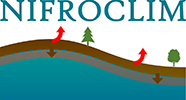Technical University Munich and the Research Unit for Comparative Microbiome Analyses at Helmholtz Zentrum München closely cooperate to develop strategies for the sustainable use of genetic resources of microorganisms to improve human, animal and plant health and to maintain soil quality and ecosystem services. Therefore, we combine high-end sequencing technologies with cultivation depending enrichment techniques, gene quantification methods, localization of microbes in their respective habitats and stable isotope probing.
As microorganisms are key drivers for nutrient turnover, understanding the structure, genetic potential and activity of the soil microbiome and how it is influenced by frequent freezing and thawing transitions in permafrost landscapes is essential to predict future N2O emissions.
In NIFROCLIM, we reconstruct microbial nitrogen (N) turnover via next generation sequencing and quantitative PCR approaches. Metagenomics are used both to describe a functional core microbiome, essential for the resilience and maintenance of soil functions, and to identify the dominant processes and microbial groups involved in N cycling. Furthermore, PacBio long read sequencing enables us to analyze complete operon structures and to identify promoters. This makes a prediction of the regulation of gene expression possible, which might be of high relevance to understand denitrification and the related N gas fluxes.

